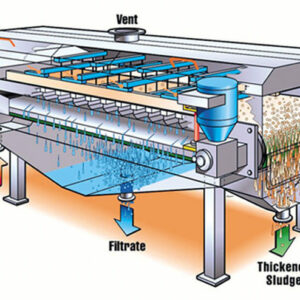Axial partial velocity and radial partial velocity of the dust collector frame
The airflow of the dust collector structure is a complex turbulent state composed of tangential, radial, and axial directions. Between them, the tangential velocity is the same in the internal and external whirlpool flow, and outward, and their sizes are different. The tangential velocity decreases with the decrease of the cylinder’s radius in the internal eddy flow and increases with the decrease of the cylinder’s radius in the external eddy flow, and reaches the value at the interface between the internal and external eddy flow. The exchange between the sidewall of the dust collector frame and the cone cyclone is the main area of secondary dust. The axial velocity is down near the outer wall of the cylinder, up in the direction near the shaft, and the velocity at the bottom of the shaft, when the airflow reverses and rises from the bottom of the cone body, the removed dust is removed again, forming an inverse mixing phenomenon, which affects the dust removal efficiency.
Due to the existence of axial partial velocity and radial partial velocity, the conventional cyclonic dust collector often forms an upper ash ring and a lower ash ring during operation. The lower ash ring has some effect on the collection and separation of dust particles. The existence of the ring causes the dust that has become trapped and separated in the lateral wall of the cylinder to move first along the outer wall of the cylinder, then inward along with the top cover, and then down along the outer wall of the inner cylinder. Short circuit and cyclone discharge, reduce dust removal efficiency. The existence of radial partial velocity also caused extreme chaos in the flow state of the internal vortex gas flow during the ascent. At this time, the dust particles only make a radial motion (negative sedimentation), automatically flow into the vortex, forming part of the dust particles discharged from the cyclone’s dust and, as a result, the cyclone’s efficiency decreases.
Due to the existence of axial partial velocity and radial partial velocity, the conventional cyclonic dust collector often forms an upper ash ring and a lower ash ring during operation. The lower ash ring has some effect on the collection and separation of dust particles. The existence of the ring causes the dust that has become trapped and separated in the lateral wall of the cylinder to move first along the outer wall of the cylinder, then inward along with the top cover, and then down along the outer wall of the inner cylinder. Short circuit and cyclone discharge, reduce dust removal efficiency. The existence of radial partial velocity also caused extreme chaos in the flow state of the internal vortex gas flow during the ascent. At this time, the dust particles only make a radial motion (negative sedimentation), they automatically run into the vortex, forming part of the dust particles that are discharged from the cyclone dust together, resulting in the efficiency of the cyclone separator. Decrease.





